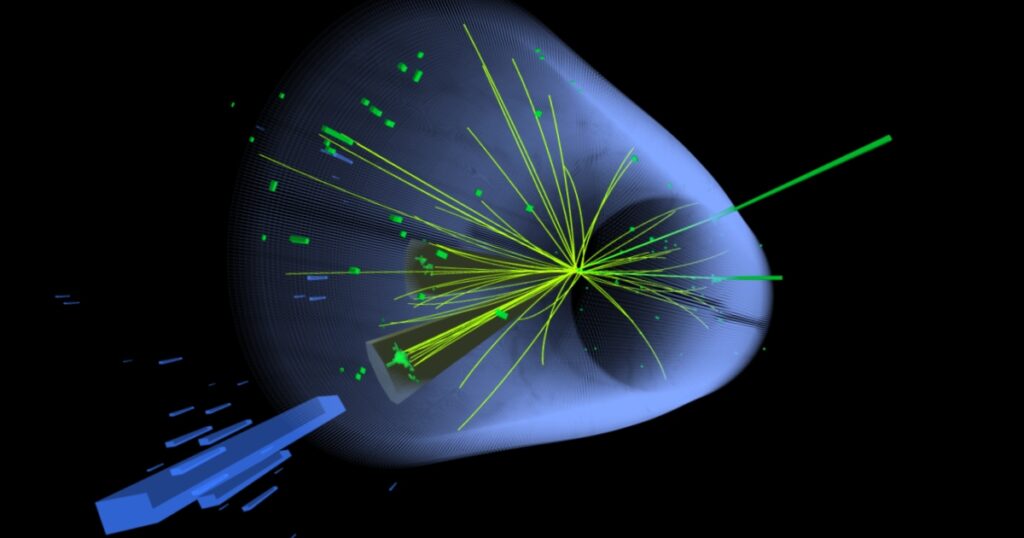The Higgs boson also known as Higgs Particle or the God Particle or the Goddamn Particle is the fundamental particle of the Higgs field, which is responsible for providing other particles their masses. It behaves like a ripple or excitation in the Higgs field.
The Higgs boson has a mass of 125 billion electron volts. It is 130 times more massive than a proton. The Higgs Boson is the only elementary particle with zero spin. The Higgs particle is named for Peter Higgs, who initially suggested the Higgs field in the mid-1960s with colleagues.

The Higgs Field:
Every particle is a wave in the field, just like light (photon) is a wave in the electromagnetic field. Similarly, the Higgs Boson is a wave in the Higgs field. The Higgs field is a theoretical field of energy that fills the entire Universe and gives mass to all elementary particles. The Higgs field itself cannot be directly observed, but its effects are detectable.
The Higgs field supplies mass to many additional elementary particles in addition to the W and Z bosons. In the absence of the Higgs field and the Brout-Englert-Higgs process, all fundamental particles would run with the speed of light in the universe.
Not only does this theory explain why particles have mass, but it also explains why their masses differ. Higgs boson itself gains mass by interacting with the Higgs field.
All the elementary particles including quarks, electrons, and bosons get their masses by interacting with the Higgs field, except for photons which don’t have any mass because it doesn’t interact with the Higgs field.
The Brout-Englert-Higgs mechanism is the name given to this mass-giving interaction with the Higgs field by physicists Peter Higgs, François Englert, and Robert Brout.
As fundamental particles move through the Higgs field, they interact with it to varying degrees. The strength of this interaction determines the mass a particle acquires.
Particles that interact more strongly with the Higgs field gain more mass, while those with weaker interactions remain lighter. The Higgs boson itself, ironically, is a massive particle. This further supports the idea of the Higgs field as the source of mass for other particles.
Discovery of Higgs Boson aka Higgs Particle or the God Particle:

An entire CERN auditorium heard the ATLAS and CMS teams’ announcement of the finding of a new particle on July 4, 2012. Scientists working at the world’s most potent particle accelerator, the Large Hadron Collider (LHC), situated at the European particle physics laboratory CERN in Switzerland, made the particle’s discovery.
This particle was short-lived, had no electrical charge, and was destroyed in the expected way as the Higgs boson. Because the Higgs boson is the only particle with a spin of zero, researchers had to determine if the particle they had detected was, in fact, the Higgs boson.
The standard model of particle physics, which provides the best explanation for the subatomic universe, was completed with the confirmation of the Higgs field and the process that gives rise to mass by the LHC.
The discovery of Higgs Boson validated decades of theoretical work and filled a critical gap in our understanding of the fundamental particles and forces that make up our universe.
The Higgs boson must be generated in a particle collision rather than being “discovered” by chance. After it is formed, it changes, or “decays,” into other particles that particle detectors can identify.
In the data that the detectors gather, physicists search for indications of these particles. The problem is that these particles are also generated in a multitude of other processes, and the Higgs boson is formed in only a small percentage of LHC collisions, roughly one in a billion.
In March 2013, they concluded that, indeed, they had found some sort of Higgs boson after looking at 2.5 times more data.
Higgs boson generation and decay provide an experimental means of measuring interaction strength. 2016 saw the discovery of interaction with tau leptons, while 2018 saw the discovery of interaction with top and bottom quarks.
The Discovery of the Higgs particle might hold clues to unsolved space mysteries like dark matter and the existence of additional Higgs bosons.
Conclusion:
The Higgs Boson provides the explanation for why we and everything we come into contact with has mass, satisfying our innate curiosity about the origins of the universe and how it came to be. Moreover, Technologies for accelerators and detectors were stretched to their limits in the h
unt for this particle, which resulted in advancements in aerospace, healthcare, and other fields.
